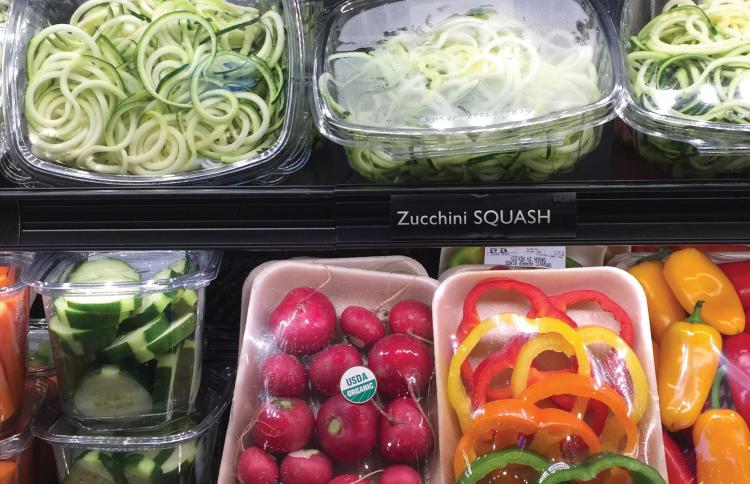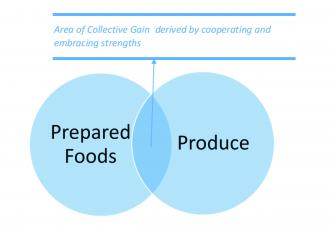“Can We Cooperate?”



In the world of food cooperatives, we often assume that the primary threats to our organizations’ success come from external sources. We see this type of challenge manifested in the form of new or increasing local competition, and we rightly focus on how to differentiate our operations and improve production to compete with new business neighbors or our more traditional external competitors.
What about the less obvious operational challenges contained in all our stores that may keep us from reaching our full potential?
Cooperatives often face internal obstacles that keep them from operating at their best and therefore put them at a competitive disadvantage in the marketplace. How can we work together more effectively within our cooperatives to better prepare our stores to compete against external threats and create an operational platform for continued organizational success?
Cultivating a collaborative culture
Is it possible for us to consciously address and remove these current obstacles to internal cooperation and discover new reserves of organizational talent and operational productivity?
By cultivating a culture of collaboration, we can break down organizational silos while highlighting the creativity and expertise of our category specialists, to amass collective gains across departments—playing to our strengths, keeping our stores relevant, and giving our co-ops a competitive edge.
Although we have “cooperation” as the basis of our co-op name, our organizations sometimes struggle to include this as a daily practice. In the pursuit of our operational goals, we have set up systems that often promote competition amongst ourselves between departments and reward individual efforts over the achievements of the team. While competition itself can be a healthy motivational aspect of our work, in such an environment we can also sometimes lose sight of our common purpose and become closed off to considerations outside of our immediate job functions.
We often look at our work through the filter of what is beneficial for a particular department, rather than taking the storewide approach of what is best for the whole of the organization—what will most please and support the needs of our customers and members. In this evolving competitive landscape, it will become increasingly important to offer a dynamic, positive, and seamlessly exceptional customer experience throughout the entire store.
The word “collaborate” comes from the Latin collaborare, which means “to labor together.” By identifying collaboration as a desirable operational characteristic and actively choosing to pursue this element in our management approach, we reinforce our cooperative values and can begin to put our principles into practice in a more tangible way.
Opportunities for collaboration
By actively looking for new ways to work together, we can identify opportunities for positive growth and build a culture that encourages innovation and group alignment. It is important to identify teamwork as a desirable operational approach and to view collaboration as a specific means to achieve higher organizational results.
Studies have shown that team members who feel that they are contributing to something larger than their own individual interests are more motivated by their work and look for opportunities to contribute. Collaboration on a storewide scale involves an awareness of being actively engaged and focused on a shared purpose. Continuing to speak to your co-op’s mission and organizational values will help frame your approach as you investigate opportunities.
Commit to open communication, bring all stakeholders to the table, and provide space for their input and feedback at the outset. When seeking to identify areas of opportunity for increased cooperation, pay special attention to areas where there are redundant practices between departments or team members, and explore a more coordinated approach.
A fresh example
Using this collaborative view, what would it look like if the co-op’s produce and prepared foods departments acted in a more coordinated manner? Could there be an interdepartmental cooperative effort to produce even more healthy and seasonal options within the prepared foods department by shifting the offerings to more locally sourced and organic ingredients?
Most produce departments would certainly benefit from an expanded value-added selection and the inclusion of additional recipe-driven offerings. Is there a practical way for the organization to support this growth opportunity when labor, time, and physical space are already limited?
Prepared foods departments specialize in the creation of great food items utilizing unique culinary skills and creativity to accomplish that.
Produce departments specialize in offering the freshest and highest quality seasonal produce available—building relationships with local farmers and multiple suppliers to support the most competitive market prices.
Both departments cut and prepare vegetables and have fresh fruit options available regularly. Both seek to capture their customers’ interest, inspire excitement, and deliver a great
experience.
By focusing on a collaborative approach, we can use the strengths of each department to add value to both and improve the offerings of the store in general while supporting the customer experience.
If the produce department coordinates the purchasing of fresh ingredients for the prepared foods department and in turn prepared foods staff use their skills to efficiently produce value-added products for the produce department, it may be possible to increase our product output, reduce redundancy in our labor, and improve our organizational teamwork.
Play your position and stay in your lane. When each of our team members is free to play to their strengths and engage passionately with their specialty discipline, each task in the operational chain gains definition and our operational processes increase in quality and value.
A coordinated effort
At the Whole Foods Co-op in Erie, Pennsylvania, they have creatively demonstrated this concept and continue to branch out into new initiatives using this approach.
The store has designed a purchasing model around the produce department and their procurement expertise. The produce buyer orders produce for multiple departments in a purchasing system that includes fresh produce, prepared foods’ in-store café, a food truck, bakery, and also catering at a separate location.
The café, food truck, bakery, and catering programs communicate their produce needs to the produce department on a pre-determined schedule. There is some discussion on pricing, seasonality, and availability. The produce manager then places the combined order with the appropriate suppliers, and when the product arrives the produce team separates the order by department.
In addition, the food service departments can often utilize the older produce items in their recipes, allowing the produce department to keep their offerings as fresh as possible. The co-op's produce manager, Sei Paulson, pointed to "several benefits to our system.” When the department recently found itself a bit long on their supply of summer squash, “the food truck was able to do a one-night special that featured squash… It allows us to cut down on waste... It's convenient for the farmers as well, because one point of contact can get their product to multiple departments. This year the co-op is working hard to offer more local products, so I'm very happy that our system allows us to easily integrate local produce into every department.”
Make a plan and take action
Developing a process to facilitate collaboration is important. Being clear about the role of stakeholders, the division of labor, and identifying how decisions will be made are all steps that will help support the collaborative process and keep things moving when the going gets tough.
One of the key aspects to creating a successful collaborative culture is the commitment to ongoing communication and feedback. After you have identified some of your initial goals on a project, it will be important to continue to measure your progress and communicate about any challenges as they arise. Set a timetable for check-ins, and organize your meetings so that all stakeholders have a voice in the proceedings.
Make efforts to solicit expert perspectives, and defer to specialists in regard to their discipline. Too often, by driving ahead with our good intentions and not fully understanding the subtleties of an operational aspect we oversee, we mandate approaches that can diminish the quality of our results. It’s okay for someone to tell the group why something won’t work. Dive into that, debunk misconceptions, and look for other avenues to achieve the intended results.
Each member of the team should be given space to articulate their progress and bring operational challenges to the group. Consider having a working group email specific to the project. Schedule regular meetings and check-ins to monitor progress and share information in more detail.
While it may still be desirable to have a project leader or facilitator, to reap the most benefit from the collaborative process the wisdom of the group should be engaged on an ongoing basis. This is where talented leaders can really shine. By actively incorporating this regular feedback into the evolving process, team members can see the results of their input and feel empowered to make a difference—improving systems, actively seeking solutions, and understanding that their skills are valued, their perspective is respected, and their contributions matter.
Measuring results
Make sure that everyone understands what part of the team’s work they are responsible for. Setting clear goals that are specific and timebound will provide measurement for the team’s progress. Make sure to invite the team members to articulate what is reasonable in relationship to their operational roles, and make room for adjustments to the timetable based on this input.
Identifying incentives for participating in the collaborative process will help keep team members on track. When a positive outcome is identified, take time to document these results and share this with the team. Operational efficiencies, increased productivity, and staff morale should all be monitored as the project progresses.
If you have a role as a leader, take time to meet with everyone involved individually, outside of the group meetings. This will provide the opportunity for more specific feedback and allow a platform to discuss how the team is experiencing the work individually. It will also allow team members to speak to more sensitive topics regarding work style and communication within the team. This transparency in process will help all involved understand how things are going and provide information for each to apply to their own part of the project.
Evolving strategies and organic processes
It’s okay if your original ideas about outcomes change. In fact, this may be a sign that the collaborative process is working. While some of your original goals will continue to be important for measuring success, as the process evolves there may be other unanticipated outcomes and additional benefits that reveal themselves. Be clear about which aspects of your collaborative process are crucial to meeting your goals, and be willing to change course to take advantage of new opportunities as your collaboration evolves.
Recognizing individuals for their specific contributions will continue to be vital to keep staff engaged and retain high performers. Finding clear ways to reward teamwork and celebrate collaborative successes will reinforce this as a core aspect of your organizational culture and encourage others to build truly cooperative operational methods.
A process in review
• Cultivate a collaborative culture. Make collaboration and teamwork a stated operational goal and spend time communicating the benefits of this practice throughout the organization. Model the collaborative approach in your own work whenever possible.
• Identify areas of opportunity to collaborate. Explore new ideas and initiatives. Pay attention to areas where there are redundant practices between departments or team members, and explore the possibility of a collaborative approach.
• Make a plan. Strategize how the team will approach the project. Draft an outline of the work, identify who will be involved and what their area of responsibility will be. Suggest an initial timeline, with the provision that it can be amended as necessary to produce the desired quality of results as the work progresses.
• Take action! Choose a project and begin working as a team.
• Monitor results. Schedule regular check-ins and meet to discuss the teams progress. Identify areas of success and document them as a measure of your progress. Ask the question; is the team effort delivering the expected results?
• Document desirable outcomes. Clearly identify the beneficial outcomes. Is this a specific project that has a discernable end goal, or is your work an ongoing process that will continue to evolve into the future?
• Know when to celebrate your success.
• Embrace change and evolve your approach. Review your work and apply what you learn to your methods going forward. Continue to seek opportunities to work together in new ways.
Summary: a positive outlook
With a commitment to the collaborative process, there are bound to be missteps and unexpected challenges. There may also be surprising positive outcomes and unanticipated benefits. Try to avoid succumbing to tunnel vision, and allow the collaborative process to continue to evolve and reveal all it has to offer.
With some diligence, patience, and attention, the operational commitment to a collaborative process can deliver exciting new opportunities, positive financial returns, and a vibrant team culture where individuals can continue to excel in their specialties while actively contributing to the success of the entire organization.
By consciously seeking ways to work together more effectively, our cooperatives can develop a dynamic operational platform for continued organizational success, and we will be better prepared to compete in the ever-changing retail landscape. •







